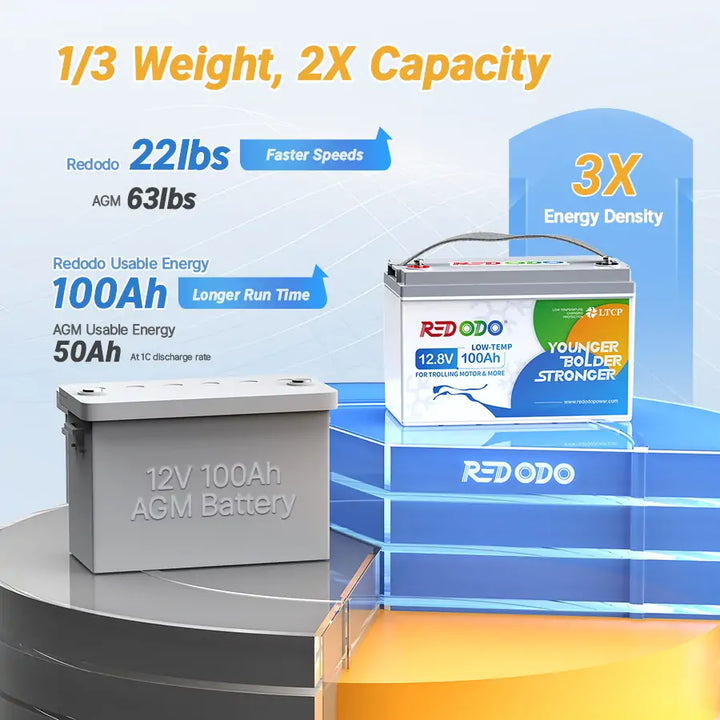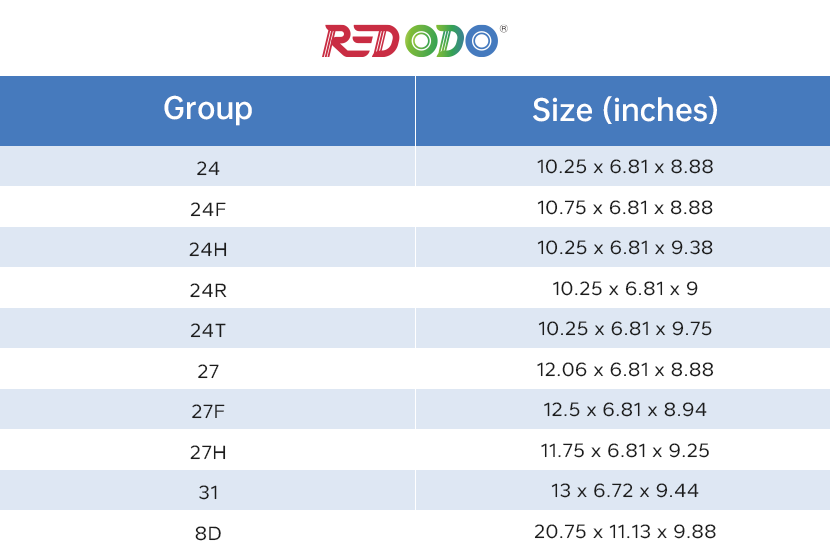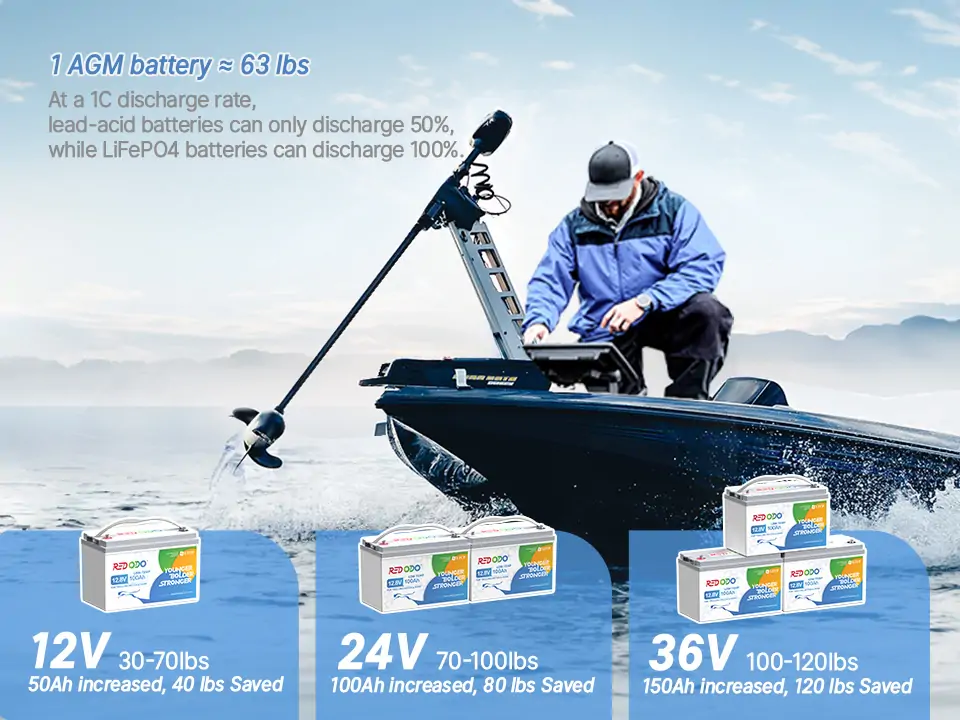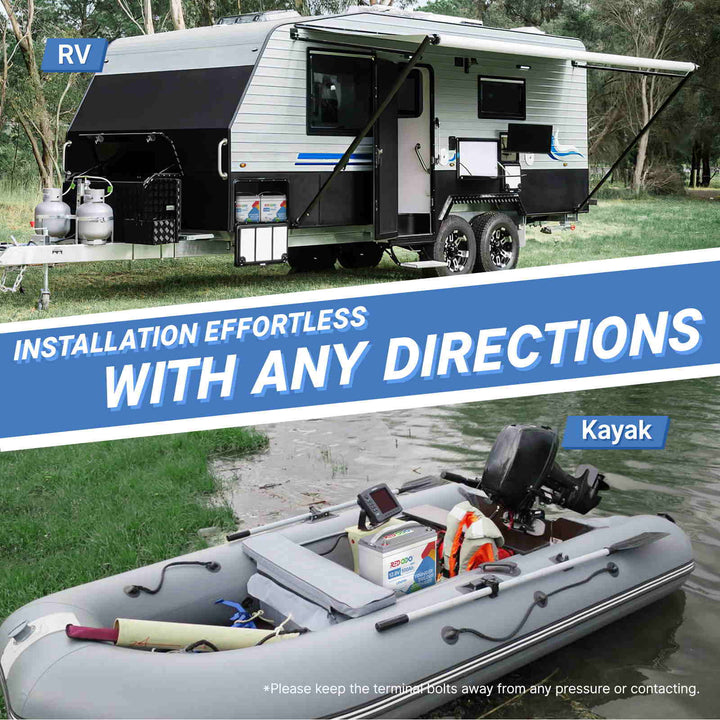Selecting the right battery size for your trolling motor is crucial for maximizing performance and efficiency during your boating adventures. But what size battery is best for your trolling motor? In this guide, we'll delve into everything you need to consider when choosing the right battery for trolling motor.
Table of Content
- What Types of Battery for Trolling Motors?
- Factors to Consider When Choosing a Trolling Motor Battery
- What Size Battery is Suitable for Trolling Motor?
- How Does a Battery Size Affect a Boat’s Performance?
- Balancing Battery Size and Performance: Upgrading to LiFePO4
- Choosing the Best Lithium Trolling Motor Battery
- What Size Battery for Kayak Trolling Motor?
- Trolling Motor Battery Maintenance and Care Tips
What Types of Battery for Trolling Motors?
Trolling motor batteries play a pivotal role in the operation of electric trolling motor setups. They supply the essential power needed to propel the boat, and the choice of battery type can significantly influence your boating endeavors.
There are generally three main types of trolling motor batteries: lead-acid batteries, AGM batteries, and lithium-ion (LiFePO4) batteries. Below, we will delve into the specific advantages and limitations of each type.
Lead-Acid Wet Batteries
The most prevalent type of battery utilized for trolling motors is the lead-acid wet cell battery. Comparable to car batteries, these batteries have been prevalent in the market for an extended period. While certain lead-acid wet cells are tailored for deep cycle marine applications, they do not deviate significantly from standard car batteries. Despite their widespread availability, they are considered outdated technologically, with superior options now accessible.
One notable concern is the risk of acid spillage during the filling process with distilled water, posing potential hazards to you, your vessel, and the environment. Although these batteries are cost-effective and functional, their usage is generally discouraged, particularly for marine vessels, due to safety considerations.
Advantages:
- Affordable
- Widely available
- Easy to find replacement parts
- Can handle shallow discharges
Disadvantages:
- Require regular maintenance, such as filling with distilled water and cleaning terminals
- Shorter lifespan compared to other battery types
- Heavy and bulky
AGM Batteries
AGM batteries have risen to prominence as the preferred choice for marine applications, thanks to their distinctive design and safety features. Unlike conventional lead-acid batteries, AGM batteries are fully sealed and spill-proof.
The primary divergence lies in the internal composition of these batteries. While lead-acid batteries rely on hydrochloric acid and lead plates, AGM batteries utilize glass mats and a gel substance to facilitate the chemical reactions responsible for storing electrical energy. This construction not only enhances the battery's performance but also eliminates the risk of leakage, rendering it a dependable option for diverse applications, including bass fishing in wet conditions.
Advantages:
- Longer lifespan compared to traditional lead-acid batteries
- Virtually maintenance-free
- More resistant to vibration and shock
- Can handle deep discharges
Disadvantages:
- More expensive than traditional lead-acid batteries
- Still heavy
LiFePO4 Lithium Batteries
Lithium batteries boast remarkable power and impressively light weight. One of their standout advantages is their consistent power discharge curve, ensuring peak power output until the battery is fully drained. For instance, while a conventional 12V 100Ah lead-acid battery weighs 60-70lbs, the Redodo 12V 100Ah lithium trolling motor battery weighs a mere 22.15 lbs. Additionally, it features built-in low-temperature protection.

Compared to traditional counterparts, lithium batteries are compact and easily fit into tight compartments. They come in various sizes and amp hour ratings, enabling boat owners to select the most appropriate battery for their vessel.
Advantages:
- Longer lifespan in contrast to traditional lead-acid batteries
- Lightweight and compact
- Maintenance-free
- Can handle deep discharges
Disadvantages:
- More expensive than lead-acid batteries
- May not be compatible with all trolling motors on the market
Learn More: Lithium vs. Lead-Acid vs. AGM
Factors to Consider When Choosing a Trolling Motor Battery
Choosing the right trolling motor battery hinges on several factors including battery voltages, motor thrusts, battery capacity, fishing conditions, and maintenance demands.
Battery Voltage
A critical factor is the battery voltage, which should align with the power requirements of the trolling motor. Typically, trolling motors include 12-volt, 24-volt, and 36-volt, depending on their power needs. Incorrect voltage usage can potentially damage the motor or diminish its efficiency.

- 12V Systems: For trolling motors with up to 55 pounds of thrust, a single 12V battery suffices.
- 24V Systems: For more powerful motors, up to 80 pounds of thrust. For AGM batteries, necessitate two 12V batteries wired in series to deliver a total of 24 volts. For lithium battery, just need a 24V trolling motor battery.
- 36V Systems: The most robust trolling motors generating over 80 pounds of thrust. Typically, AGM require three 12V batteries wired in series to yield a total of 36 volts, while lithium battery just need a 36V trolling motor battery.
Explore further about LiFePO4 Lithium Batteries in Series & Parallel to optimize your setup.
Trolling Motor Thrust Rating
The thrust output of the trolling motor is another critical factor influencing the required battery size. The thrust rating of your trolling motor, measured in pounds (lbs). A higher-thrust motor generally demands a battery with a larger Ah rating to ensure sufficient runtime.
For instance, a trolling motor with 30-55 lbs of thrust typically pairs well with a 12V battery with at least 50Ah, while motors with 70 lbs or more thrust may require higher-capacity batteries with at least 100Ah.
Here is a trolling motor battery size chart for different thrusts:

Battery Capacity
Battery capacity, measured in ampere-hours (Ah), which determines the amount of energy the battery can store and supply to the motor. Higher capacity batteries offer longer run times but are heavier and more costly.
It's important to highlight that certain trolling motors are specifically engineered to operate with particular battery types, underscoring the significance of consulting the manufacturer's recommendations before purchasing a battery.
Fishing Conditions
Environmental factors such as wind strength and water currents can significantly impact the power demands of the trolling motor. In the presence of strong winds or currents, a greater power output is required, leading to the necessity for a larger battery size to accommodate these heightened power demands.
Battery Maintenance
Maintenance of your battery remains paramount, regardless of its type. For lead-acid batteries, routine upkeep such as checking fluid levels and cleaning terminals is indispensable for maximizing performance and lifespan. AGM batteries demand less maintenance but should undergo periodic assessments regarding charging and storage conditions. Lithium-ion batteries entail minimal upkeep, making them the best batteries for trolling motor.
What Size Battery is Suitable for Trolling Motor?
The most prevalent battery group sizes for trolling motors include Group 24, Group 27, and Group 31. Nevertheless, determining the appropriate size hinges on factors such as your boat's dimensions, cargo weight, and the power requirements of the motor.
For smaller boats with lighter loads and less powerful motors, a group 24 battery may suffice. Group 24 batteries typically measure approximately 10 x 6.88 x 9.94 inches and boast a capacity of around 70-85 Ah. However, the Redodo Group 24 battery boasts a capacity of 100Ah.
For larger boats carrying heavier loads and equipped with more powerful motors, a group 27 or 31 battery may be indispensable. Group 27 batteries generally measure about 12 x 6.75 x 8.88 inches and offer a capacity of around 90-105 Ah. Meanwhile, Group 31 batteries are even larger, with dimensions typically around 13 x 6.81 x 9.44 inches and a capacity ranging from 100-125 Ah. Below is the BCI battery size format for reference.

Learn More: Group 24 VS Group 31 Deep Cycle Batteries
How Does a Battery Size Affect a Boat’s Performance?
Selecting the correct battery size for your boat is essential to ensure optimal performance and safety on the water. The battery's size directly influences the boat's electrical system, engine performance, fuel consumption, and overall stability.
Utilizing an improperly sized battery can strain the engine, leading to increased fuel consumption, and may cause damage to the boat's electrical components, resulting in appliance malfunctions and potential hazards such as fluid leaks, sparks, and overheating.
Both oversized and undersized batteries can have adverse effects on the boat's performance and battery longevity. Oversized batteries can exert unnecessary strain on the electrical system, potentially causing damage and reducing efficiency. Conversely, undersized batteries may fail to deliver adequate power for the boat's electrical demands, resulting in shortened run time or complete power loss.
Balancing Battery Size and Performance: Upgrading to LiFePO4
Opting for a larger battery undoubtedly grants more power and extended run times for the trolling motor. However, the drawback lies in the increased weight and bulkiness of larger batteries, potentially affecting the boat's overall performance and maneuverability.
Conversely, smaller batteries boast lighter weights and are easier to handle, yet they may fall short in providing adequate power for prolonged usage. Hence, it's imperative to strike a delicate balance between battery size and the boat's weight, thrust capacity, and prevailing fishing conditions to ensure optimal performance.
Thus, finding a battery that strikes the perfect equilibrium between size and performance, considering factors such as boat weight, thrust capacity, and fishing conditions, becomes paramount. The solution lies in upgrading to a LiFePO4 battery, renowned for its high energy density and lighter weight, offering an optimal balance of power and maneuverability.

Choosing the Best Lithium Trolling Motor Battery
Below is a summary table presenting the recommended Redodo LiFePO4 lithium batteries, categorized by motor voltage, motor thrust, and the maximum recommended amperage of the batteries. Each recommendation is accompanied by specific justifications. Explore Redodo Trolling Motor Batteries to discover and select your ideal battery.
| Voltage of Motor | Motor Thrust | Recommended Max Amp of Batteries | Recommended Redodo LiFePO4 Batteries | Recommended Reasons |
|---|---|---|---|---|
| 12V | 20 ~ 30 lb | 50A | 12V 50Ah Lithium Battery | Cost-effective |
| 12V | 30 ~ 70 lb | 100A | 12V 100Ah Lithium Trolling Motor Battery | Cost-effective, Low-temp, Lighter |
| 24V | 70 ~ 100 lb | 100A | 24V 100Ah Lithium Battery | Cost-effective |
| 36V | 100 ~ 120 lb | 100A | Larger-capacity |
What Size Battery for Kayak Trolling Motor?
For kayak fishing enthusiasts, opting for a lithium battery is highly recommended. Their compact size and light weight have minimal impact on the kayak's performance. Although they may come with a higher price tag, they are widely regarded as the optimal choice for most kayak setups. In fact, many leading trolling motors for kayaks are now outfitted with lithium batteries.
12V 100Ah Mini Lithium Battery is an ideal light weight battery for kayak trolling motor. It weighs in at just 19.84 lbs, measuring just 10.23 x 5.23 x 8.95 inches to ensure more space of your boat.
Trolling Motor Battery Maintenance and Care Tips
To guarantee the peak performance, durability, and safety of your electric trolling motor system, it's crucial to prioritize the maintenance and upkeep of your trolling motor batteries. Here are some tips and guidelines to assist you in this endeavor:
Charging Techniques
Using a charger tailored to your battery type is crucial for ensuring peak performance and preventing potential damage. Ensure that the charger aligns with the voltage of your battery. If uncertain, refer to the table below for guidance. Avoid overcharging, as it can diminish battery lifespan or lead to damage. Charge the battery after each use and avoid leaving it in a discharged state for prolonged periods.
Read More: Can a LiFePO4 battery be charged with a standard charger?
Battery Storage Tips
Ensuring the proper storage of your battery is essential for maintaining its longevity and performance. Store the battery in a cool, dry location, shielded from direct sunlight and extreme temperatures.
Additionally, it's advisable to disconnect the battery from the trolling motor before storage. For flooded lead-acid batteries, maintain appropriate water levels. If storing the battery for an extended duration, fully charge it before storage and periodically recharge it.
Signs of a Failing Battery
Vigilance for indicators of a failing battery is paramount to sidestep safety risks and uphold peak performance. Such signs may encompass challenges in starting the trolling motor, diminished power output, sluggish or incomplete charging, bulging or distorted battery casing, and leaks or corrosion near the terminals. If any of these signs emerge, it could indicate the need for battery replacement or necessitate professional intervention.
Conclusion
To wrap up, the selection of the appropriate battery size for your trolling motor is paramount to ensure peak performance and durability. Utilizing an incorrectly sized battery can result in diminished power output, shortened battery lifespan, and potential safety risks. Hence, it's imperative to factor in considerations such as motor thrust, boat weight, and usage patterns to determine the ideal battery size.
By dedicating attention to choosing the correct battery size and properly caring for it, you can enhance the efficiency and reliability of your trolling motor system. Therefore, do not underestimate this critical aspect of your boating journey and make the appropriate battery selection today!
Subscribe our newsletters to discover more about experience the power of LiFePO4, and share your story to get 5% off from Redodo.
![[Full Guide] What Size Battery for Trolling Motor?](http://www.redodopower.com/cdn/shop/files/Reodod_logo1.jpg?crop=center&format=webp&height=24&v=1730185167&width=24)
Redodo
![[Full Guide] What Size Battery for Trolling Motor?](http://www.redodopower.com/cdn/shop/files/Reodod_logo1.jpg?crop=center&format=webp&height=24&v=1730185167&width=24)
Redodo
Recent Post

How Long Will a 100Ah Battery Run an Air Conditioner?

A Full Review of Redodo 12V 140Ah Group 31 Deep Cycle Battery

How Much Does it Cost to Replace Golf Cart Batteries?

What Size Fish Finder Battery Do I Need? 2025 Updated


![⚡[$165 after Sign-Up] Redodo 12V 100Ah Lithium Trolling Motor Battery With Low Temp Protection](http://www.redodopower.com/cdn/shop/files/Redodo12V100Ahlow-tempbattery.webp?v=1738462317)
![⚡[$184 after Sign-Up] Redodo 12V 100Ah Group 24 Bluetooth LiFePO4 Battery | Real-Time Battery Monitoring | For RV, Marine, Solar](http://www.redodopower.com/cdn/shop/files/group_24_BT_312a5c81-ec74-4307-a7f5-c05e195d5246.jpg?v=1742971855)
![⚡[$184 after Sign-Up] Redodo 12V 100Ah Group 31 Bluetooth Lithium Battery | Real-Time Battery Monitoring | For RV, Marine, Solar](http://www.redodopower.com/cdn/shop/files/GROUP_31_0501cb0c-ed50-4c4a-b78e-b7ab501d90b4.jpg?v=1742971970)
![⚡[$460 after Sign-Up] Redodo 12V 140Ah Dual Purpose Marine Battery, 1000 CCA](http://www.redodopower.com/cdn/shop/files/Redodo-12V-140Ah-cranking-battery.jpg?v=1742812553)
![⚡[$340 after Sign-Up] Redodo 12V 200Ah Low Temp Lithium Battery | 1280W Load Power | For RV, Solar, Off-Grid](http://www.redodopower.com/cdn/shop/files/Redodo12V200Ahlowtempcutofflifepo4battery_0e3042f8-41ec-49a2-8586-705d8fa25a7c.jpg?v=1741251295)
![⚡[$179 after Sign-Up] Redodo 12V 100Ah Bluetooth Marine Battery | For Marine, Trolling Motors, RV](http://www.redodopower.com/cdn/shop/files/5s5p_58b30e00-41f5-4642-acb1-954626d7c92f.jpg?v=1742972693)
![⚡[$165 after Sign-Up] Redodo 12V 50Ah Bluetooth Battery for Trolling Motors (Up to 70lb Thrust)](http://www.redodopower.com/cdn/shop/files/12v50Ahlithiumbattery0.webp?v=1741251960)
![⚡[$238 after Sign-Up] Redodo 12V 140Ah Group 31 Lithium Battery with Bluetooth | 40% More Capacity | For RV, Marine, Solar Home](http://www.redodopower.com/cdn/shop/files/140AH_07f9edc2-5c68-46aa-a613-0af0fe1669bd.jpg?v=1742967763)
![⚡[$303 after Sign-Up] Redodo 36V 50Ah Lithium Trolling Motor Battery for 36V Trolling Motors with 100-120 lbs](http://www.redodopower.com/cdn/shop/files/Redodo36V50AhTrollingMotorBattery38.4V.webp?v=1741251125)
![⚡[$206 after Sign-Up] Redodo 24V 50Ah Bluetooth Trolling Motor Battery | For 24V Trolling Motors with up to 100 lbs](http://www.redodopower.com/cdn/shop/files/Redodo24V50AhTrollingMotorBatterywithBluetooth02.webp?v=1741251660)